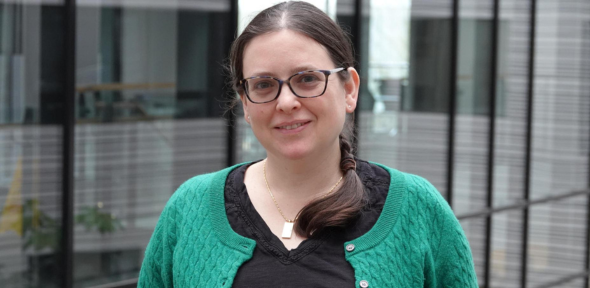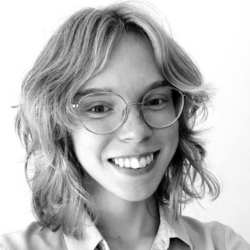
This blog is part of an interview series by Tara Murphy.
|
I’m Tara, a NanoDTC student here at the Cavendish Laboratory in the University of Cambridge. Since arriving here last year, I’ve come to realise the exceptional work being carried out by the brilliant women at the Cavendish Laboratory and I think it’s crucial to bring attention to the remarkable achievements and invaluable contributions of these women, both past and present. Join me, as I sit down with the remarkable women of Cavendish Laboratory, delving into their personal journeys, research interests, and experiences in the scientific community. This week I spoke with Professor Sian Dutton whose research focuses on manipulating structure and composition of materials to influence functionality. Here, she shared with us her early experience of studying Natural Sciences at Cambridge, her research as a postdoc in America to finding her way back in physics at Cavendish Laboratory! |
Interview with Professor Sian E Dutton
Could you tell me how you found yourself at the Cavendish Laboratories in Cambridge?
When I was at school, I really liked all the sciences, particularly chemistry. For me, science was a natural choice to study! When I was thinking about what I wanted to do as an undergraduate, I was primarily interested in chemistry, but I also liked the idea of keeping my options open. So, I applied for natural sciences here in Cambridge, which is where I ended up coming for my degree. I remember not liking university physics back then!
Really?! What didn't you like about it?
I found the math quite difficult, and it just didn't interest me as much as chemistry did, which I found fascinating, and also the mineral sciences and materials.
When I came to the end of my studies, I still really liked studying, and I was really interested in the project I'd done, which was on electron microscopy of mixed metal oxides. I really wanted to stay and do more research; I just couldn't imagine stopping! I settled on going to Oxford to complete my Ph.D. in solid-state chemistry and magnetic properties. I completed the Ph.D. thinking that at the end, I would get a job of some description and not really intending to stay in academia.
But after my Ph.D., I was offered a postdoc at Princeton. Again, this was a chemistry project, but it was working in collaboration with a group of physicists at Johns Hopkins University on a project called the 'Institute for Quantum Matter'. In particular, I was looking at quantum materials and how they can be exploited and manipulated.
That sounds incredible! I recall you saying that you didn't like university physics, yet your projects were becoming more on the boundary between physics and chemistry. Was this intended?
That’s right! I was going on completing more physics like projects, but in my opinion, chemists and physicists really think about the same things. The language is very different, and often chemists will think about it perhaps a little bit more qualitatively with orbitals and perhaps pictures, whereas physicists will write an equation.
That’s a super interesting perspective! Can you tell me about the work you carried out with them?
One of the things I did during that period was discover a very interesting material by accident!
Throughout my time there, I wanted to make a different type of material. I thought I was going to create a different type of connectivity within the material, and I had a hypothesis. Then, when I made it, it formed a different crystal structure. After working on this for a while, we discovered it had these 1D spin chains and we could see evidence of short-range correlations and the absence of long-range mathematical ordering.
It turns out that the material we prepared was very close to a quantum critical point, and it was one of the best examples of a particular type of phase space in 1D spin chains. I didn't know this, but it turns out there was somebody else in the Chemistry department, a theoretical chemist who spent their entire life working on the theory of these things and doing simulations. He was very excited because he had all this new data and this new material that he could model. Through that, we started collaborating and we worked together to understand the material. They did some very sophisticated analytical models to describe the magnetism and the heat capacity we were seeing, which agreed beautifully with the data, which when we read the literature, nobody had plotted their graphs on the same scales.
That's amazing!
It was at that point I think I decided to stay in academia, and I started looking for jobs again after my postdoc. I became aware of the Winton program for the physics of sustainability and applied for a fellowship. It was in physics, but Cambridge at the time was quite willing to support a more chemistry-based research program in physics.
So, after traveling all over the world from America and back, you found yourself in Cambridge again?
Yes! I was really pleased to be in Cambridge. It has great facilities. At the time, there wasn't a huge amount of solid-state chemistry, which is my area, and so they felt there was space to expand. Originally my research program was focused on looking at new cathode materials for rechargeable batteries, and that still is a large part of my research program.
What type of work are you carrying out now?
I would classify my research broadly into four main areas, all of which are really looking at how we can manipulate structure and composition of materials to influence functionality. That may be the electrochemical properties in the work we do on rechargeable batteries. We look at both new cathode materials for lithium and sodium-ion battery systems.
We’ve also done some work on magnesium-ion batteries. Magnesium is your carrier ion, so you have two electrons to your external circuit rather than one. It sounds like it would be amazing. It turns out, practically, it's quite challenging for a number of reasons, and we've been working on this for a long time. Another topic is the low-temperature magnetic cooling, where it's primarily looking at rare-earth oxides and borates.
I recently had a student who looked at double perovskites, which you may have come across. It turns out these are relatively dense magnetic lattices, but they behave as if they're diluted magnetic spins. What this means is you have behaviour from isolated ions in a solid matrix. For magnetocaloric, that's good. We're trying to build on that and leverage that, as well as looking at other material systems. The other topics are looking at structural property relationships in hybrid perovskites, which involves collaborating with the Optoelectronics Group.
Seems like you have a lot going on! As a final question for Ph.D. students, for postdocs, for people who would read this blog, do you have any advice that you'd give to someone going into academia now or thinking about their future in academia?
I think I've really been helped by having mentors who've been really supportive and also highlighted opportunities. I think one important thing is telling people what you think you want to do and then they will help you, but also make you aware if there's something available you should be applying for or doing. I think just not being shy about that. It's not just your Ph.D. supervisor, but lots of people will be willing to help or point you in the right direction, if you tell them that's what you'd like. I think that's quite important.
Thank you so much. That was such an interesting conversation. Thank you so much for your time and insights!
To know more about Sian Dutton's research visit - https://duttongroup.weebly.com/
Read other blogs from Tara - https://murphytarra.wixsite.com/tara-murphy-website/blog
Banner Image: Sian Dutton

